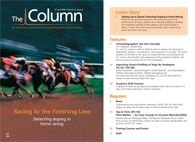Getting Up to Speed: Detecting Doping in Horse Racing
With the ever-growing market for new drugs to enhance performance of horses, analysts are continually battling to develop new analytical methods to beat doping. LCGC spoke to Karen Y. Kwok from The Hong Kong Jockey Club in Hong Kong, China, about her work in this area.
Photo Credit: Frank Whitney/Getty Images

With the ever-growing market for new drugs to enhance performance of horses, analysts are continually battling to develop new analytical methods to beat doping. LCGC spoke to Karen Y. Kwok from The Hong Kong Jockey Club in Hong Kong, China, about her work in this area.
Q. You were selected to present an oral presentation on your work detecting anabolic steroids in horsehair at HPLC 2015 in Geneva, Switzerland. Why is the use of anabolic steroids a concern in horse racing?
A:
Androgenic and anabolic steroids (AASs) are substances that can be used to increase muscle strength and improve physical performance. They have been used as performance enhancing drugs in human and equine sports since 1960s and are prohibited substances. Since 2014, the use of AASs is prohibited at any time during the career of a racehorse under Article 6E of the International Agreement on Breeding, Racing and Wagering published by the International Federation of Horseracing Authorities.
1
Q. In your view, what are the main challenges associated with the analysis of banned drugs in horse racing?
A:
The rapid development of biological and medical sciences has led to the availability of more and more prohibited substances. Unfortunately, no matter how fast racing chemists can develop new methods to detect emerging prohibited substances, there will unavoidably be a time lag before an effective detection method can be developed. In addition, the number of prohibited substances in horseracing is very high, covering not just performance enhancing drugs but stoppers (performance impairing substances) as well. There is no way a racing laboratory can detect all prohibited substances - it can only make the best use of its available resources in order to achieve the widest drug coverage possible.
Q. Why is horsehair your sample of choice for drug screening in horse racing rather than blood or urine?
A:
Urine, blood and hair each has its own merit as a specimen for the purpose of drug testing. The main advantage of hair is no doubt its wide detection window. A particular characteristic of hair analysis is the possibility to establish the possible timing of drug exposure through segmental hair analysis. Such information can be very useful for positive case investigation. Unlike urine and blood, hair is very stable, easily transported and stored, and it is hard to adulterate. Hair sampling is also non-invasive. Having said this, many drugs are not amenable to hair testing at the moment and can only be detectable in urine or blood. Urine, blood and hair are therefore complementary matrices in doping control testing.
Q. Why did you develop a method for the detection of 48 androgenic anabolic steroids (AASs) and/ or their esters in horsehair?2
A:
Androgenic and anabolic steroids (AASs) are commonly available in their esterified forms, enabling them to be stored in the muscle and released slowly, to prolong their effect. For some endogenous AASs such as testosterone, the identification of their esters in the hair is an irrefutable evidence for their exogenous origin. The AASs is a class of prohibited substances banned in horseracing at all times, with the duration of effect longer than their detection time in urine and blood. Hair is therefore an ideal specimen for the retrospective identification of the use of AASs in a racehorse.
Q. What are the main factors to consider when developing sample preparation methods for horsehair samples prior to ultrahigh-performance liquid chromatography–high-resolution mass spectrometry (UHPLC–MS)?
A:
Unlike urine and blood, hair is in constant contact with the environment. Stringent decontamination protocol is required to avoid false positives. As the amount of drugs in hair is generally very low (can range from ppt to low ppb level), the method used for extracting incorporated drugs must have adequate recovery to allow for their detection by UHPLC-MS. Hair is also a very complex matrix. An effective clean-up is usually required to minimize matrix effect on the MS.
Q. What were the challenges you faced and how did you overcome them? What are the advantages of your method compared to other methods?
A:
A major challenge was to establish an extraction method which can effectively remove chemical interferences and yet maintain adequate recovery for subsequent UHPLC/HRMS analysis. Satisfactory sample clean-up was eventually achieved using a combination of liquid-liquid extraction followed by solid phase extraction (SPE). Chemical interferences were further reduced by exploiting the high-resolution capability of the orbitrap type MS using a narrow mass window (±10 ppm) for the selective reaction monitoring (SRM) transitions. The accuracy of mass assignment was enhanced by post-column addition of a lock mass reference compound benzyldimethylphenylammonium to correct possible mass shifts of target analytes. To our knowledge, this was the first report of a comprehensive screening method for detecting as many as 48 AASs and/or their esters in horse hair.
Q. What were your key results? Is the method appropriate for use in the field? What are you working on next?
A:
A sensitive accurate mass screening method to detect AASs and/or their esters (at high ppt to low ppb levels) has been developed. This method, with additional target steroids added since my presentation, has been applied to the screening of horse hair samples and to confirm the presence of an AAS ester in a referee horse hair sample (B sample). In fact, since completion of our research work, many more targets have already been added to the screening method. Future work would be to verify the applicability of our method using genuine post-administration horse hair samples and to detect the presence of metabolites of AASs and their esters.
Q. Are there similarities between drugs used in doping for horses and humans? Are analytical methods interchangeable?
A:
Prohibited substances used in doping for horses and human athletes can be similar. However, they can also be different not only because the respective rules are different (for example, the use of non-steroidal anti-inflammatory drugs are not controlled in human sports) but also because some drugs don’t produce the same effects in the two species. Furthermore, prohibited substances for horses are not only confined to performance enhancing drugs (including tranquilizers that can calm a nervous horse) but also performance impairing drugs. The scope of prohibited substancs for horses is therefore much wider in comparison with those for human athletes. Analytical methods are not directly interchangeable between horses and humans. Biological samples from horses, especially urine, are much more complex compared to those from humans, which require more extensive clean-up procedures prior to drug detection. Furthermore, drug metabolisms in the horse and human are often not the same.
Q. If asked by a young scientist starting out in the field for advice, what would you say?
A:
As a young scientist, I find the field of doping control very meaningful and challenging. Integrity and fairness are the corner stones of horseracing as in human sports, and doping control testing is a vital element for upholding these values. Doping control testing operates under a forensic environment since the findings have legal consequence. Besides the challenging science, newcomers must also be well versed with all aspects of forensic analysis, such as maintaining proper chain of custody and appearing as an expert witness in courts of law, etc. We need to learn and seek advice from the more experienced chemists and develop our own critical thinking to handle different cases. In addition, doping control testing is quite demanding, as the number of emerging prohibited substances will only keep increasing; hence we need to keep abreast of new doping trends and technological advances in different fields of science. The most important advice I can offer is that we need to have a strong passion for our work and should never give up when faced with challenges. I am sure you will find huge satisfaction from your job in the field of doping control.
References
1. http://www.horseracingintfed.com/resources/2015Agreement.pdf 2. K.Y. Kwok, T.L.S. Choi, W.H. Kwok, and T.S.M. Wan, “Detection of Anabolic Steroids and/or Their Esters in Horse Hair Using Ultra High Performance Liquid Chromatography-High Resolution Mass Spectrometry,” poster presented at HPLC 2015, Geneva, Switzerland, 21–25 June 2015.

Dr. Karen Y. Kwok
received her PhD in environmental analytical chemistry from the City University of Hong Kong. She then worked as a senior research associate at the State Key Laboratory in Marine Pollution, City University of Hong Kong. In 2013, she joined the Racing Laboratory of The Hong Kong Jockey Club as Chemist. Since then she has devoted herself to doping control in equine sports and analytical chemistry. Dr. Kwok is a Member of the Royal Society of Chemistry (MRSC), has published 2 book chapters and 10 papers in international peer-reviewed journals, and has participated in over 10 international conferences.

LCGC Blog: Forensics Laboratories Underassess Uncertainty in Blood Alcohol Determinations
August 8th 2023The level of uncertainty provided by most forensic laboratories for reported blood alcohol results has been woefully underassessed. Not only is this bad science, but someone’s civil liberties may be at stake.







